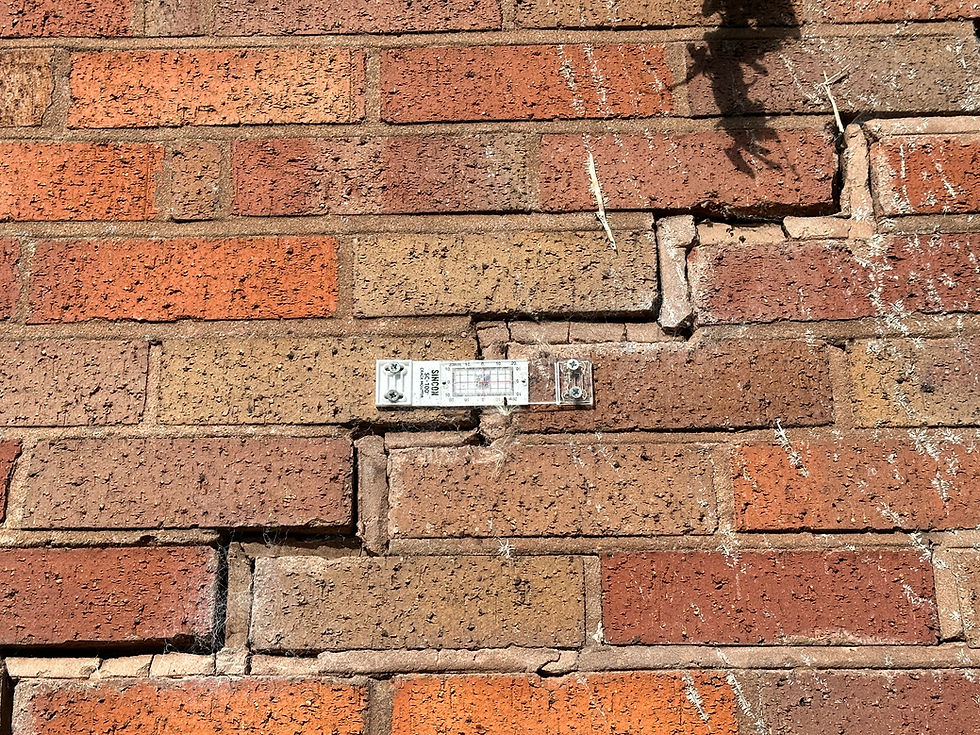How to Identify Subsidence and Structural Movement Cracking in Your Home
- Charles Riley BA(Hons) DipSurv AssocRICS VRS

- Sep 13, 2023
- 3 min read
Updated: Sep 18, 2023
- Brooks Surveyors Blog

Subsidence can pose a significant threat to your homes structural integrity if left unchecked, in this post we will explain How to Identify Subsidence and what to do if you suspect you have an ongoing subsidence issue.
Your home is more than just a place to live; it's a significant investment that deserves protection. Among the various concerns homeowners may face, subsidence is a critical issue that can compromise your property's integrity. In this blog post, we will delve into how to identify signs of subsidence in your home so that you can take prompt action to safeguard your investment.
Understanding Subsidence
Before we discuss identifying signs, let's clarify what subsidence is:
Subsidence: Subsidence occurs when the ground beneath your home sinks or settles, leading to the sinking or settling of the structure as well. This can result from factors such as changes in soil moisture, geological conditions, or nearby excavation work.
Identifying Signs of Subsidence
1. Cracks in Walls and Floors:
- Horizontal cracks: These are often a significant indicator of subsidence and should be treated with utmost seriousness. They may appear in walls or along the ceiling.
- Vertical cracks: Vertical cracks in walls are relatively common and can result from settling or minor structural movement. However, they should be monitored for any widening.
- Diagonal cracks: Diagonal cracks, especially those wider at the top, can strongly suggest subsidence or significant structural problems.
2. Window and Door Misalignment:
- Doors and windows that no longer close properly or have visible gaps around the frames may indicate subsidence. This occurs because the frames may have shifted due to changes in the building's structure.
3. Uneven Floors:
- If you notice that your floors are sloping or uneven, it could be a sign of subsidence. Use a level to check the floors in different areas of your home.
4. Cracks in Exterior Brickwork or Masonry:
- Cracks in the exterior brickwork or masonry of your home may be indicative of subsidence. Pay attention to cracks that are wider at the top than at the bottom, suggesting sinking or settling.
5. Sticking Windows and Doors:
- Difficulty in opening or closing windows and doors may result from subsidence, especially if it's a recent development.
6. Gaps Around Chimneys or Bay Windows:
- Gaps forming between your home's structure and features like chimneys or bay windows can also be a sign of subsidence.
What to Do if You Suspect Subsidence
If you notice any of the above signs or have concerns about subsidence in your home, it's essential to take action promptly:
1. Consult a Professional: Reach out to a qualified structural engineer or a building surveyor to assess the situation. They can identify the cause and severity of the subsidence and recommend appropriate solutions.
2. Monitor Changes: Keep an eye on any cracks or other signs you've noticed and document their progression over time. This documentation can help professionals assess the situation more accurately.
3. Address Drainage Issues: Poor drainage can contribute to subsidence. Ensure your property's drainage systems are functioning correctly and redirect water away from your foundation.
4. Foundation Repair: If subsidence is confirmed, you may need foundation repair or other necessary measures. Follow the recommendations of the professionals you consult.
Identifying subsidence in your home is crucial for ensuring its long-term stability and value. By recognizing the signs early and seeking professional guidance, you can take proactive steps to address this issue and protect your most significant investment – your home. Timely action can save you both money and stress in the long run.
#HomeMaintenance #StructuralIssues #Subsidence #CrackDetection #FoundationRepair #PropertyInvestment #BuildingIntegrity #StructuralEngineer #HomeInspection #DIYHomeCare #SinkingHome #HomeStability #HouseMaintenance #PropertyProtection #FoundationProblems #CrackIdentification #StructuralHealth #HomeSafety #BuildingMaintenance #HouseRepair #SignsOfSubsidence #PropertyValue #StructuralAssessment #ProfessionalConsultation #FoundationSettlement #TimelyAction #SoilMoistureChanges #GeologicalConditions #WindowAlignment #DoorAlignment #ChimneyMaintenance
.png)






Comments